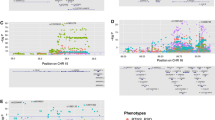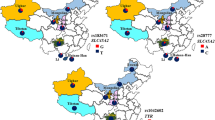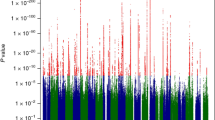Abstract
Previous biological studies showed evidence of a genetic link between obesity and pigmentation in both animal models and humans. Our study investigated the individual and joint associations between obesity-related single nucleotide polymorphisms (SNPs) and both human pigmentation and risk of melanoma. Eight obesity-related SNPs in the FTO, MAP2K5, NEGR1, FLJ35779, ETV5, CADM2, and NUDT3 genes were nominally significantly associated with hair color among 5,876 individuals of European ancestry. The genetic score combining 35 independent obesity-risk loci was significantly associated with darker hair color (beta-coefficient per ten alleles = 0.12, P value = 4 × 10−5). However, single SNPs or genetic scores showed non-significant association with tanning ability. We further examined the SNPs at the FTO locus for their associations with pigmentation and risk of melanoma. Among the 783 SNPs in the FTO gene with imputation R 2 quality metric >0.8 using the 1,000 genome data set, ten and three independent SNPs were significantly associated with hair color and tanning ability respectively. Moreover, five independent FTO SNPs showed nominally significant association with risk of melanoma in 1,804 cases and 1,026 controls. But none of them was associated with obesity or in linkage disequilibrium with obesity-related variants. FTO locus may confer variation in human pigmentation and risk of melanoma, which may be independent of its effect on obesity.


Similar content being viewed by others
References
Adan RAH, Hillebrand JJG, Rijke C, Nijenhuis W, Vink T, Garner KM, Kas MJH (2003) Melanocortin system and eating disorders. Ann NY Acad Sci 994:267–274
Cone RD (2006) Studies on the physiological functions of the melanocortin system. Endocr Rev 27:736–749
Danforth C (2012) Hereditary adiposity in mice. Obes Res 4:96–100
Dickies MM (1962) A new viable yellow mutation in the house mouse. J Hered 53:84–86
Fawcett KA, Barroso I (2010) The genetics of obesity: FTO leads the way. Trends Genet 26:266–274
Frayling TM, Timpson NJ, Weedon MN, Zeggini E, Freathy RM, Lindgren CM, Perry JRB, Elliott KS, Lango H, Rayner NW (2007) A common variant in the FTO gene is associated with body mass index and predisposes to childhood and adult obesity. Science 316:889
Frisancho AR, Wainwright R, Way A (1981) Heritability and components of phenotypic expression in skin reflectance of Mestizos from the Peruvian lowlands. Am J Phys Anthropol 55:203–208
Gantz I, Fong TM (2003) The melanocortin system. Am J Physiol Endocrinol Metab 284:E468–E474
Gerken T, Girard CA, Tung YCL, Webby CJ, Saudek V, Hewitson KS, Yeo GSH, McDonough MA, Cunliffe S, McNeill LA (2007) The obesity-associated FTO gene encodes a 2-oxoglutarate-dependent nucleic acid demethylase. Science 318:1469
Gerstenblith MR, Shi J, Landi MT (2010) Genome-wide association studies of pigmentation and skin cancer: a review and meta-analysis. Pigment Cell Melanoma Res 23:587–606
Getting SJ (2006) Targeting melanocortin receptors as potential novel therapeutics. Pharmacol Ther 111:1–15
Harrison GA, Owen J (1964) Studies on the inheritance of human skin colour. Ann Hum Genet 28:27–37
He M, Cornelis MC, Franks PW, Zhang C, Hu FB, Qi L (2010) Obesity genotype score and cardiovascular risk in women with type 2 diabetes mellitus. Arterioscler Thromb Vasc Biol 30:327–332
Heston W, Vlahakis G (1961) Influence of the Ay gene on mammary-gland tumors, hepatomas, and normal growth in mice. J Natl Cancer Inst 26:969
Heston W, Vlahakis G (1968) C3H-Auv—a high hepatoma and high mammary tumor strain of mice. J Natl Cancer Inst 40:1161–1166
Kilpeläinen TO, den Hoed M, Ong KK, Grøntved A, Brage S (2011) Obesity-susceptibility loci have a limited influence on birth weight: a meta-analysis of up to 28,219 individuals. Am J Clin Nutr 93:851
Krude H, Biebermann H, Luck W, Horn R, Brabant G, Gruters A (1998) Severe early-onset obesity, adrenal insufficiency and red hair pigmentation caused by POMC mutations in humans. Nat Genet 19:155–157
Larder R, Cheung M, Tung Y, Yeo GSH, Coll AP (2010) Where to go with FTO? Trends Endocrinol Metab 22(2):53–59
Loos RJF, Lindgren CM, Li S, Wheeler E, Zhao JH, Prokopenko I, Inouye M, Freathy RM, Attwood AP, Beckmann JS (2008) Common variants near MC4R are associated with fat mass, weight and risk of obesity. Nat Genet 40:768
Nan H, Kraft P, Hunter DJ, Han J (2009a) Genetic variants in pigmentation genes, pigmentary phenotypes, and risk of skin cancer in Caucasians. Int J Cancer 125:909–917
Nan H, Kraft P, Qureshi AA, Guo Q, Chen C, Hankinson SE, Hu FB, Thomas G, Hoover RN, Chanock S (2009b) Genome-wide association study of tanning phenotype in a population of European ancestry. J Investig Dermatol 129:2250–2257
Rees JL (2003) Genetics of hair and skin color. Annu Rev Genet 37:67–90
Rees JL (2004) The genetics of sun sensitivity in humans. Am J Hum Genet 75:739–751
Sanchez-Pulido L, Andrade-Navarro M (2007) The FTO (fat mass and obesity associated) gene codes for a novel member of the non-heme dioxygenase superfamily. BMC Biochem 8:23
Scott LJ, Mohlke KL, Bonnycastle LL, Willer CJ, Li Y, Duren WL, Erdos MR, Stringham HM, Chines PS, Jackson AU (2007) A genome-wide association study of type 2 diabetes in Finns detects multiple susceptibility variants. Science 316:1341
Scuteri A, Sanna S, Chen WM, Uda M, Albai G, Strait J, Najjar S, Nagaraja R, Orrú M, Usala G (2007) Genome-wide association scan shows genetic variants in the FTO gene are associated with obesity-related traits. PLoS Genet 3:e115
Shoag J, Haq R, Zhang M, Liu L, Rowe GC, Jiang A, Koulisis N, Farrel C, Amos CI, Wei Q (2013) PGC-1 coactivators regulate MITF and the tanning response. Mol Cell 67(5):e207–e208
Speliotes EK, Willer CJ, Berndt SI, Monda KL, Thorleifsson G, Jackson AU, Allen HL, Lindgren CM, Luan J, Mägi R (2010) Association analyses of 249,796 individuals reveal 18 new loci associated with body mass index. Nat genet 42(11):937–948
Thorleifsson G, Walters GB, Gudbjartsson DF, Steinthorsdottir V, Sulem P, Helgadottir A, Styrkarsdottir U, Gretarsdottir S, Thorlacius S, Jonsdottir I (2008) Genome-wide association yields new sequence variants at seven loci that associate with measures of obesity. Nat Genet 41:18–24
Trewick SC, McLaughlin PJ, Allshire RC (2005) Methylation: lost in hydroxylation? EMBO Rep 6:315–320
Willer CJ, Speliotes EK, Loos RJF, Li S, Lindgren CM, Heid IM, Berndt SI, Elliott AL, Jackson AU, Lamina C (2008) Six new loci associated with body mass index highlight a neuronal influence on body weight regulation. Nat Genet 41:25–34
Yen T, Gill A, Frigeri L, Barsh G, Wolff G (1994) Obesity, diabetes, and neoplasia in yellow A (vy)/-mice: ectopic expression of the agouti gene. FASEB J 8:479–488
Acknowledgments
We are indebted to the participants in the NHS, HPFS, and MD Anderson melanoma case–control study for their dedication to this research. We thank the following state cancer registries for their help: Alabama, Arizona, Arkansas, California, Colorado, Connecticut, Delaware, Florida, Georgia, Idaho, Illinois, Indiana, Iowa, Kentucky, Louisiana, Maine, Maryland, Massachusetts, Michigan, Nebraska, New Hampshire, New Jersey, New York, North Carolina, North Dakota, Ohio, Oklahoma, Oregon, Pennsylvania, Rhode Island, South Carolina, Tennessee, Texas, Virginia, Washington, and Wyoming.
Author information
Authors and Affiliations
Corresponding author
Electronic supplementary material
Below is the link to the electronic supplementary material.
Rights and permissions
About this article
Cite this article
Li, X., Liang, L., Zhang, M. et al. Obesity-related genetic variants, human pigmentation, and risk of melanoma. Hum Genet 132, 793–801 (2013). https://doi.org/10.1007/s00439-013-1293-4
Received:
Accepted:
Published:
Issue Date:
DOI: https://doi.org/10.1007/s00439-013-1293-4




